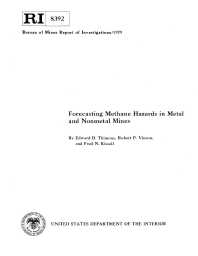Mining Publication: Forecasting Methane Hazards in Metal and Nonmetal Mines
Original creation date: January 1979
Because of the high number of accidental methane gas ignitions in metal and nonmetal mines, the Bureau of Mines searched for a simple guideline that would allow mine personnel to evaluate the methane hazard in a given mine. Air samples were collected by the Bureau in 53 metal and nonmetal mines and analyzed for trace evidence of methane gas. Samples were collected in the returns and at the working faces. Those mines classified as gassy by the Mine Safety and Health Administration had a significantly higher average methane concentration than those classified as nongassy. Of the 9 gassy mines sampled, 7 had methane concentrations above 100 ppm, whereas only 1 of the 44 nongassy mines had a concentration above 100 ppm. The 100-ppm concentration may be used as a simple and convenient guideline for forecasting the methane hazard in a mine, whether or not the mine is classified as gassy. There was no consistent correlation between commodity mined and methane concentration, nor was there a correlation between mine depth and methane concentration. Neither of these factors can be considered a guideline for predicting methane hazards.
Authors: ED Thimons, RP Vinson, FN Kissell
Report of Investigations - January 1979
NIOSHTIC2 Number: 10000683
Pittsburgh, PA: U.S. Department of the Interior, Bureau of Mines, RI 8392, 1979 Jan; :1-9
See Also
- Degasification System Selection for U.S. Longwall Mines Using an Expert Classification System
- Development and Application of Reservoir Models and Artificial Neural Networks for Optimizing Ventilation Air Requirements in Development Mining of Coal Seams
- Experimental Studies on the Origin and Accumulation of Coalbed Gas
- Geological Factors Affecting Methane in the Beckley Coalbed
- Geology and Methane Content of the Upper Freeport Coalbed in Fayette County, Pa.
- History of the Mining Program
- Hydraulic Stimulation of a Surface Borehole for Gob Degasification
- Modeling and Prediction of Ventilation Methane Emissions of U.S. Longwall Mines Using Supervised Artificial Neural Networks
- Remote Methane Sensors
- Removing Methane (Degasification) from the Pittsburgh Coalbed in Northern West Virginia
- Content source: National Institute for Occupational Safety and Health, Mining Program


 ShareCompartir
ShareCompartir
